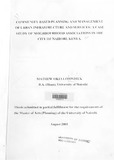| dc.description.abstract | Pursuant to the Local Government Act Cap 265, Local Authorities are mouopolisticallv
mandated to provide urban infrastructure and services, a mandate they have dismally
performed. This has led to deplorable state of urban infrastructure and services a cross the
country including the capital City of Nairobi. Heaps of uncollected garbage, blocked drains,
burst sewers, potholes, and poor conditions of sanitation are nightmares to the city dwellers.
This sorry state 'of affairs has been met with open criticisms directed and tile cuv
government a1;d disillusionment among the city resident community Small self-help groups
that began-to voice this concern have today crystallized . into formidable neighbourhood '
associations, responding by filling, albeit haphazardly, this service gap. At the policy level,
however, mechanisms of involving the residents in planning and sustainable management of
the city do not exist This study sought to asses the capacity of the neighbourhood
associations by finding out the nature of urban infrastructure and services that they provide;
the obstacles that they face: to suggest a participatory model for the provision of the same;
and to make policy recommendation with a view to integrating the communities and thereby
enhancing effective urban planning and sustainable management. Through purposive and
intensive sampling techniques, three neighbourhood associations were sampled and by
simple random sampling, sixty households were ultimately sampled for the studv Together
with the household surveys, twenty-four institutional questionnaires and checklists were
used. Research findings have been presented using descriptive method of data analysis,
computer aided graphics and photography In spite of' the harsh policy em ironment, the
.
residents' associations, this study found out.jio respond to their local problems and prox ide
a number of services as summarized in table 61. In this bid, however, thev lace a
,
considerable number of obstacles ranging from policy at the top to threats "1'0111 their elected
leaders and the private developers. This study has suggested a participatory approach to
urban planning and sustainable management based on partnerships. The various I,ev
stakeholders have been identified and thelr responsibilities specified Recommendations
.~
touching on lenislation. various ~overnlllellt policies governing urban infrastructure and serx ice provisions have been made in the final chapter | en |

